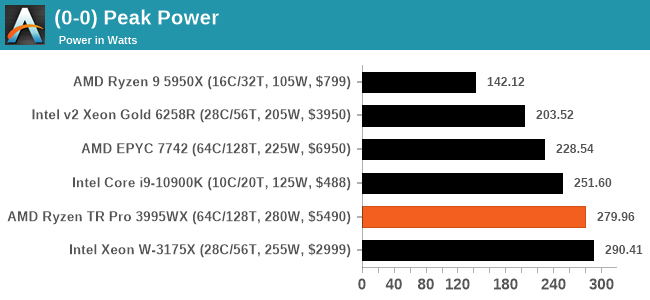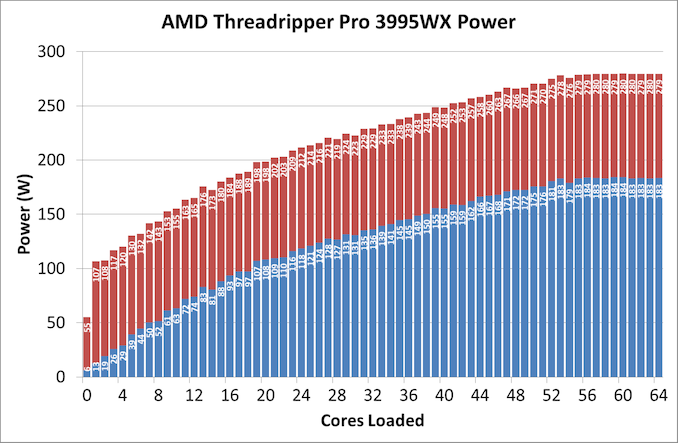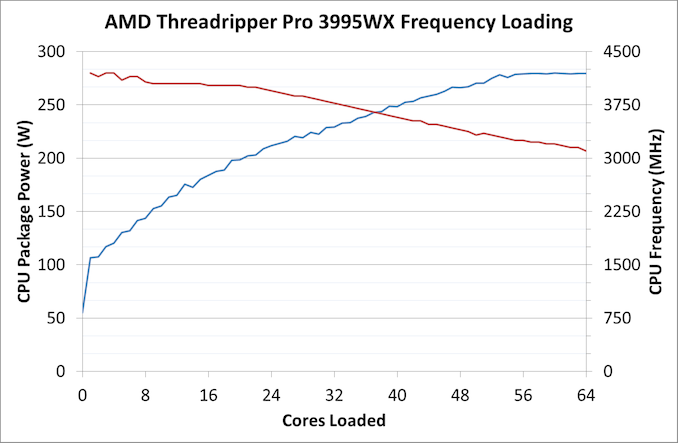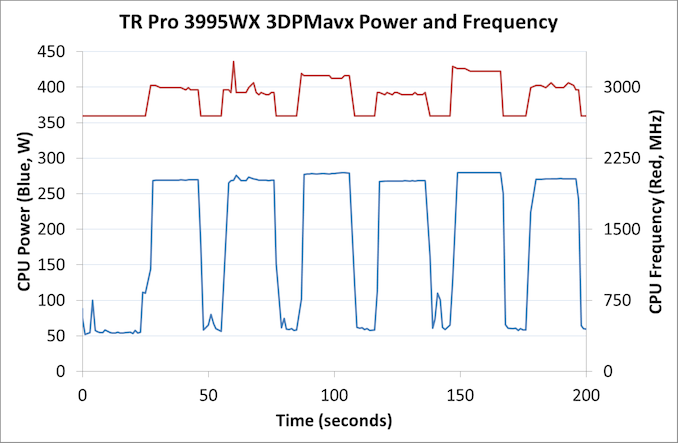64 Cores of Rendering Madness: The AMD Threadripper Pro 3995WX Review
by Dr. Ian Cutress on February 9, 2021 9:00 AM EST- Posted in
- CPUs
- AMD
- Lenovo
- ThinkStation
- Threadripper Pro
- WRX80
- 3995WX
Power Consumption
The nature of reporting processor power consumption has become, in part, a dystopian nightmare. Historically the peak power consumption of a processor, as purchased, is given by its Thermal Design Power (TDP, or PL1). For many markets, such as embedded processors, that value of TDP still signifies the peak power consumption. For the processors we test at AnandTech, either desktop, notebook, or enterprise, this is not always the case.
Modern high performance processors implement a feature called Turbo. This allows, usually for a limited time, a processor to go beyond its rated frequency. Exactly how far the processor goes depends on a few factors, such as the Turbo Power Limit (PL2), whether the peak frequency is hard coded, the thermals, and the power delivery. Turbo can sometimes be very aggressive, allowing power values 2.5x above the rated TDP.
AMD and Intel have different definitions for TDP, but are broadly speaking applied the same. The difference comes to turbo modes, turbo limits, turbo budgets, and how the processors manage that power balance. These topics are 10000-12000 word articles in their own right, and we’ve got a few articles worth reading on the topic.
- Why Intel Processors Draw More Power Than Expected: TDP and Turbo Explained
- Talking TDP, Turbo and Overclocking: An Interview with Intel Fellow Guy Therien
- Reaching for Turbo: Aligning Perception with AMD’s Frequency Metrics
- Intel’s TDP Shenanigans Hurts Everyone
In simple terms, processor manufacturers only ever guarantee two values which are tied together - when all cores are running at base frequency, the processor should be running at or below the TDP rating. All turbo modes and power modes above that are not covered by warranty. Intel kind of screwed this up with the Tiger Lake launch in September 2020, by refusing to define a TDP rating for its new processors, instead going for a range. Obfuscation like this is a frustrating endeavor for press and end-users alike.
However, for our tests in this review, we measure the power consumption of the processor in a variety of different scenarios. These include full AVX2/AVX512 (delete as applicable) workflows, real-world image-model construction, and others as appropriate. These tests are done as comparative models. We also note the peak power recorded in any of our tests.
AMD Ryzen Threadripper Pro 3995WX
The specifications for this processor list 64 cores running at a TDP of 280 W. In our testing, we never saw any power consumption over 280 W:

Going through our POV-Ray scaling power test for per-core consumption, we’re seeing a trend whereby 40% of the power goes to the non-core operation of the system, which is also likely to include the L3 cache.

Red = Full Package, Blue = CPU Core only (minus L3 we think)
We only hit the peak 280 W when we are at 56-core loading, otherwise it is a steady climb moving from 7 W/core in the early loading down to about 3 W/core when fully loaded. What this does for core frequencies is relatively interesting.
Our system starts around 4200 MHz, which is the rated turbo frequency, settling down to 4000-4050 MHz in that 8-core to 20-core loading. After 20 cores, it’s a slow decline at a rate of 25 MHz per extra core loaded, until at full CPU load we observe 3100 MHz on all cores. This is above the 2700 MHz base frequency, but also comes out to 2.86 W per core in CPU-only power, or 4.37 W per core if we also include non-CPU power. Note that non-CPU power in this case might also include the L3.
For an actual workload, our 3DPMavx test is a bit more aggressive than POV-Ray, cycling to full load for ten seconds for each of its six algorithms then idling for a short time. In this test we saw idle frequencies of 2700 MHz, but all-core loading was at least 2900 MHz up to 3200 MHz. Power again was very much limited to 280 W.












118 Comments
View All Comments
brucethemoose - Tuesday, February 9, 2021 - link
There are large efforts in various communities, from Rust and C++ to Linux distros and game engines, to improve autovectorization.This means that more software should support AVXwhatever with minimal or no support from devs as time goes on.
Also, one can"t always just "go to the GPU." Video encoding is a great example where this won't work.
RSAUser - Wednesday, February 10, 2021 - link
NVENC seems to work pretty well.eastcoast_pete - Wednesday, February 10, 2021 - link
The newest generation of NVENC (since Turing) is indeed quite capable at encoding and transcoding to AVC and h265. That ASIC has come a long way, and is really fast. However, for customized encoding situations, the story shifts; that's where CPU-based encoding comes into its own. Also, if you want AV1 encoding, we're still OOL on GPUs; if that has changed, I'd love to know. Lastly, a lot of the work these workstations are used for is CGI and editing, and for those, a combination of lots of RAM, many-core CPUs like these here and 1-2 higher end GPUs is generally what people use who do this for a living.GeoffreyA - Friday, February 12, 2021 - link
NVENC, VCE, etc., work brilliantly when it comes to speed, but if one is aiming for best quality or size, it's best to go for software encoding. x264 does support a bit of OpenCL acceleration but there's hardly any gain, and it's not enabled by default. Also, even when AV1 ASICs are added, I've got a feeling it'll fall well below software encoding.phoenix_rizzen - Tuesday, February 9, 2021 - link
More like, unless you absolutely NEED AVX-512 support, there's absolutely no reason to use an Intel setup.Pick a Ryzen, Threadripper, or EPYC depending on your needs, they'll all be a better value/performer than anything Intel currently has on the market.
twtech - Tuesday, February 9, 2021 - link
It's workload-dependent, and what you're looking for. While regular TR supports ECC, it doesn't support registered ECC, which is 99% of ECC memory. The 8 memory channels also make a big difference in some workloads, such as compiling code. Also the TR Pro has a lot more PCIE lanes, as well as better support for business/corporate management.So I agree with your statement if you are a solo operator with a workload that is not only not very memory dependent, but not very memory-bandwidth dependent either.
eastcoast_pete - Wednesday, February 10, 2021 - link
For the use case covered here (customized CPU rendering), those many cores are hard to beat. In that scenario, the main competitors for the TR pros are the upcoming, Zen 3-based Epyc and non-pro TRs. Unfortunately, Intel is still way behind. What I wonder about also is whether some of these rendering suites are also available for ARM's Neoverse arch; some of those 128+ core CPUs might be quite competitive, if the software exists.wumpus - Wednesday, February 10, 2021 - link
I'm guessing that a lot of the times that feature will be ECC. How many tasks worth doing on a 5-figure workstation are worth having botched bytes thanks to a memory error?Granted, a lot of the times that ECC is needed are also going to be the >256GB cases, but ECC is pretty important (if only to known that there *wasn't* a memory error).
The Hardcard - Tuesday, February 9, 2021 - link
While the EPYC name is epic, it doesn’t scream “for heavyweight computational workloads” like Threadripper does. Both names are candidates for bonuses, but whoever thought up Threadriipper should get the bigger one.If the same person is responsible for both names, then the title AMD Marketing Fellow was earned.
Oxford Guy - Tuesday, February 9, 2021 - link
Threadripper is even more corny than EPYC. Neither inspire much confidence from a professional standpoint, sounding like gamer speak.